Job Disruption or Destruction: Adopting AI at the Workplace
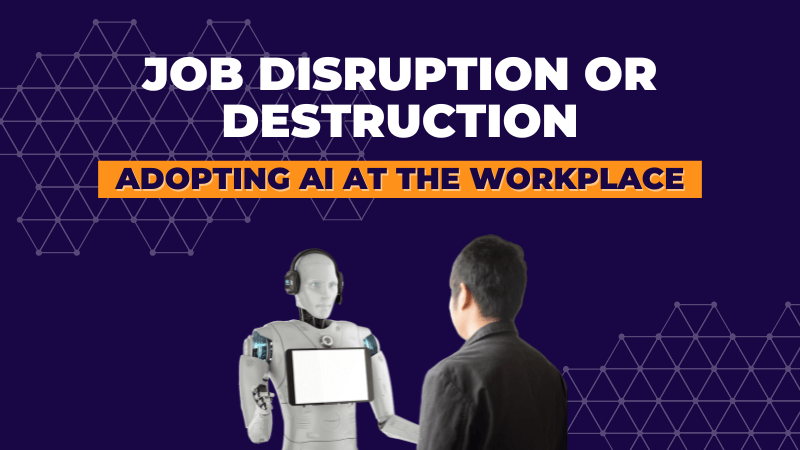
Artificial intelligence (AI) is rapidly transforming the way we work. It allows us to automate repetitive tasks, improve decision making and optimise operations. This allows employees to focus on creative work. Ultimately, this leads to increased productivity, accuracy and enhanced customer service quality. Additionally, AI enables businesses to identify inefficiencies and bottlenecks which results in cost savings and improved efficiency.
Nevertheless, there are also concerns about job displacement and potential biases.
AI can automate jobs that involve repetitive tasks. Consequently, this may result in job losses, across sectors such as manufacturing and customer service. Furthermore, AI systems can exhibit biases that may lead to discriminatory outcomes.
As organisations strive for operations and enhanced efficiency questions arise about the impact of AI adoption on jobs. In this blog article, we will explore the advantages and challenges of adopting AI in the workplace. We will explore strategies for navigating these changes, provide industry insights and address considerations that surround this transformative shift.
Understanding the AI-Driven Disruption
The concept of job disruption in the context of AI implementation revolves around the shift of traditional job roles and employment patterns as a result of the integration of advanced AI technologies. Job disruption spans from automation to job transformation, fundamentally reshaping the landscape of modern employment.
We can observe AI’s impact on employment through several distinct viewpoints. Automation, perhaps the most visible one, involves the replacement of routine and repetitive tasks by AI-powered systems.
This can lead to making human workers who were previously engaged in these tasks obsolete. This involves particularly sectors like manufacturing, logistics, and customer service for example.
However, job disruption is not only about replacing existing roles but also transforming them.
AI has the potential to augment human capabilities. This can lead to the creation of hybrid roles where humans collaborate with AI systems to achieve higher efficiency and successfully deal with more complex tasks. As a result, this transformation would require a shift in skills and expertise.
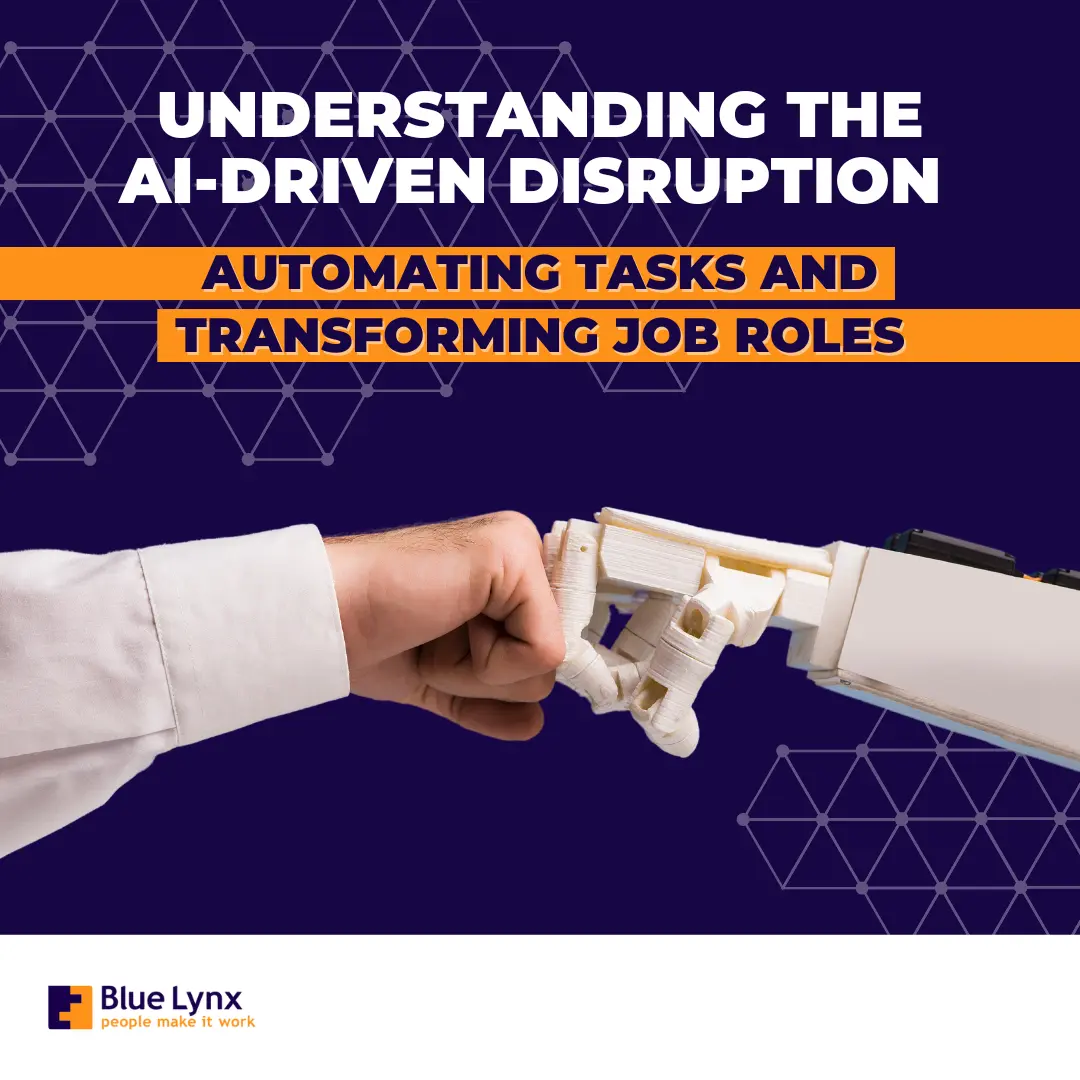
Several industries and sectors have witnessed AI-induced changes over the past few decades.
Manufacturing has witnessed significant automation as robots and AI-controlled machinery take over assembly lines.
Retail has successfully introduced cashier-less stores and personalised shopping experiences driven by AI algorithms.
Along with these, many administrative tasks, data analysis, and even creative content are undergoing a massive transformation through AI’s optimisation potential.
AI-driven disruption revolves around the automation of routine tasks and the transformation of job roles to integrate AI tools and technologies. While concerns about job displacement may be valid, the emergence of new opportunities and the augmentation of human capabilities present a more nuanced picture.
Industries across the board are experiencing AI-induced changes, and adaptability will be the key for both people and businesses to use AI to their advantage while mitigating its disruptive effects.
The Dichotomy of AI: Displacement and Transformation
The integration of AI into various industries and sectors brings along both job displacement and job transformation. These two main outcomes exemplify the dual nature of AI’s impact on the workforce.
One of the most concerning aspects of AI integration is the direct replacement of human workers by automated systems or AI-driven technologies. Tasks and roles that were previously done by people are now executed more efficiently and cost-effectively by machines or AI algorithms. As a result, this often leads to concerns about unemployment.
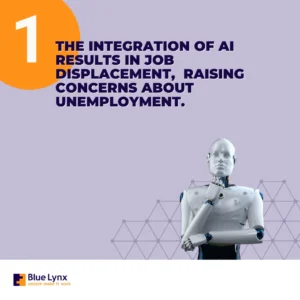
For instance, in manufacturing, industrial robots have replaced humans in repetitive assembly line work. Similarly, in customer service, chatbots and virtual assistants are increasingly handling routine inquiries. Naturally, this reduces the need for human customer support agents.
On the other hand, job transformation represents AI integration and learning how to adopt new software and technologies at the workplace.
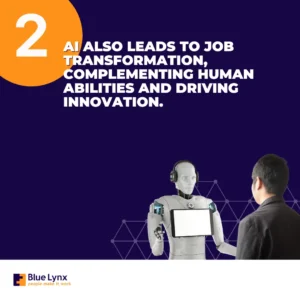
Nevertheless, apart from causing job loss, AI technologies can often complement human abilities and drive innovative businesses forward.
In the real world, several companies and industries exemplify these outcomes. Amazon’s use of robots in its fulfilment centres is a classic example of job displacement. Robots have taken over many of the tasks previously done by human workers, leading to concerns about job loss.
Adapting Careers in the Face of AI
The rapid advancement of Artificial Intelligence is progressively reshaping the employment landscape. As AI systems take on routine and repetitive tasks across various industries, the need for workforce adaptation becomes increasingly evident. Failure to do so may result in job displacement or stagnation in roles that could become obsolete.
Upskilling and reskilling have emerged as key strategies to match the evolving job requirements in the AI era. Upskilling involves acquiring additional skills and knowledge within one’s current field to stay competitive in the market.
For example, a data analyst might upskill by learning advanced data visualisation techniques to complement their data analysis skills.
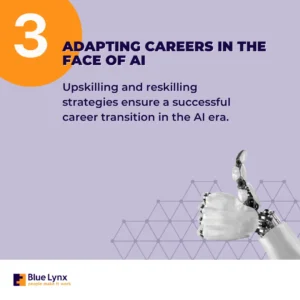
Reskilling, on the other hand, involves acquiring entirely new skills to transition into a different career path. This might entail someone in a manufacturing role reskilling to become a robotics technician, thus aligning their skills with the growing demand for maintaining AI-powered machinery.
Successful career transitions in AI involve both upskilling and reskilling. Imagine you are a marketing manager who recognises the increasing role of AI in digital marketing. You would want to proactively learn how to leverage AI tools for data-driven marketing campaigns to make sure you are up to date in this evolving field.
Similarly, imagine John, a factory worker whose job was automated, decides to reskill to become a drone operator for aerial inspections in industries like agriculture and infrastructure maintenance. His ability to adapt to new technology ensured his continued employment and allowed him to pursue new exciting career opportunities.
Executive Search and Recruitment in the Age of AI
It’s not just about filling job positions, but rather discovering people who are flexible enough to adapt to swiftly evolving roles and technologies.
This is where executive search firms and recruiters come in, connecting businesses and the talent they require.
AI has brought about a significant transformation in the way we approach recruitment. With the help of algorithms and machine learning, the hiring process has become more efficient.
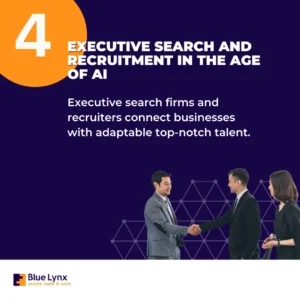
It helps organisations identify candidates with the specific skills and qualities needed for AI-driven roles.
What’s more, executive search firms specialise in understanding the evolving job landscape, offering valuable insights into the skills and profiles that will be in high demand in the near future.
As companies grapple with the challenges of both job displacement and transformation, executive search and recruitment firms offer strategic guidance in constructing a workforce that seamlessly incorporates AI technologies.
They assist in aligning organisational objectives with talent acquisition strategies, ensuring that businesses not only adapt to AI-driven changes but also flourish in this era of transformation.
Strategies for Mitigating AI-Related Job Loss
As the integration of AI into the workforce continues, proactive strategies for both employees and employers are essential to mitigate job loss and ensure a smooth transition to the AI-driven economy.
Proactive strategies for employees:
- Continuous learning: Stay updated with AI trends and acquire new skills relevant to emerging roles. This could involve taking online courses, attending workshops, or getting certified in AI-related fields.
- Fostering a growth mindset: Be open to embracing changes and learn from failures. This will help you adapt to the evolving job market and be more resilient in the face of job loss.
- Networking: Build relationships with people in your field, including AI experts. This can help you stay informed about job opportunities and get recommendations.
Employers also play a vital role in mitigating job loss. They can implement strategies such as job redesign. This involves identifying tasks that AI can automate and then reallocating employees to higher-value tasks.
Proactive strategies for employers:
- Job redesign: After automating repetitive tasks, redirect employee efforts to tasks that require creativity, critical thinking, and emotional intelligence.
- Providing training and development: Offer training and development programs focused on AI technologies. This will help employees upskill and reskill, ensuring that they remain valuable contributors to the organisation.
- Creating a culture of innovation: Create a culture of innovation where employees are encouraged to experiment with new technologies and ideas. This will help the organisation stay ahead of the curve and avoid being disrupted by AI.
Various programs and initiatives around the world are dedicated to reskilling and upskilling the workforce in response to AI-related job disruptions. Governments and educational institutions often collaborate to offer subsidised or free courses in AI, data science, and related fields.
For instance, Singapore’s SkillsFuture program provides up to 50% to 90%, of SSG-supported courses to all Singaporeans in the workforce to acquire skills in AI and other emerging technologies.
Private companies like IBM have launched AI education programs to equip employees and the wider workforce with AI-related skills. These initiatives are instrumental in bridging the skill gap and enabling people to navigate the AI-driven job market successfully.
Ethical Considerations in AI-Driven Job Disruption
The adoption of AI technologies in the workplace raises profound ethical dilemmas, particularly in the context of job displacement. As organisations strive to improve efficiency and reduce costs through automation, they often grapple with the ethical implications of rendering human workers obsolete.
One of the primary concerns is the potential for widespread job loss, which can lead to financial instability, unemployment, and social inequality. The ethical dilemma here lies in the tension between technological progress and its human cost. Balancing these interests requires organisations to carefully consider the consequences of AI-driven job disruption.
The ethical dilemma lies in whether organisations should have the responsibility to support displaced employees during the AI transition. This includes offering retraining, fair severance packages, outplacement services, and upskilling programs to help workers adapt to the changing job landscape.
Transparency, fairness, and empathy should be the cornerstones of AI implementation. Transparency involves communicating to employees the intentions and implications of AI adoption.
This not only builds trust but also allows workers to make informed decisions about their careers. Fairness entails ensuring that AI-driven decisions, such as those related to hiring, promotion, or performance evaluation, are free from bias and discrimination.
AI systems must be designed and trained to avoid reinforcing existing inequalities. Empathy is vital in recognising the emotional and psychological toll that job displacement can have on individuals and communities.
Industry-Specific Insights: AI’s Impact on Job Markets
AI’s impact on job markets varies significantly across different industries and professions.
There is a potential for industry-specific partnerships between AI and human workers.
AI can be used to automate tasks that are repetitive and time-consuming, freeing up human workers to focus on more creative and strategic work. AI can also be used to augment human intelligence, providing workers with insights and recommendations that they would not be able to access on their own.
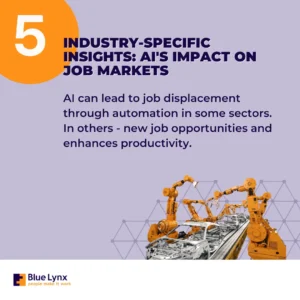
In some industries, AI is leading to job displacement, as machines can automate tasks that were previously done by humans.
For example, AI-powered chatbots are being used to replace customer service representatives and self-driving cars are being developed to replace truck drivers.
In other industries, AI is creating new job opportunities. For example, AI-powered data scientists are in high demand, as businesses need to collect and analyse data to make informed decisions. AI is also implemented in creating new products and services, which leads to the creation of new jobs.
Here are some specific examples of how AI is being used in different industries:
- Healthcare
AI is being used to develop new treatments for diseases, diagnose diseases more accurately, and personalise treatment plans. For example, IBM Watson is being used to help doctors diagnose cancer more accurately.
- Finance
AI is being used to develop new financial products and services, such as robo-advisors that can provide financial advice to customers. For example, BlackRock’s Aladdin platform is used by financial institutions to manage risk and make investment decisions.
- Retail
It is used to improve customer service, personalised shopping experiences, and optimise inventory. Amazon uses AI to recommend products to customers and personalise their shopping experience.
- Manufacturing
AI is being used to automate tasks, improve quality control, and optimise production. For example, GE uses AI to inspect jet engines for defects.
- Transportation
Develop self-driving cars, optimise traffic flow, and improve safety. Waymo is developing self-driving cars that are being tested in several cities around the world.
To Sum It Up
Job displacement as a result of integration of AI technology, raises valid concerns about unemployment in some sectors. In contrast, job transformation offers the potential for greater productivity and efficiency. However, employees must be equipped with the necessary skills to collaborate effectively with AI systems. Balancing these outcomes is crucial for harnessing the benefits of AI while mitigating its disruptive effects on the job market.
In the face of AI-driven disruptions, the ability to adapt one’s career has become a valuable asset. It’s no longer enough to rely only on existing skills. Proactive engagement in upskilling and reskilling is essential for staying relevant in a job market undergoing constant transformation.
The ethical considerations in AI-driven job disruption underscore the need for a holistic and human-centred approach to AI adoption. Organisations must recognise their ethical obligations to both employees and society at large. By prioritising fairness and transparency businesses can not only navigate the ethical complexities of AI but also they can ensure the well-being of their workforce and communities.
